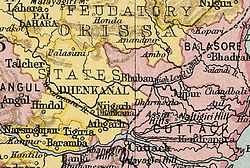Baramba State
| Baramba State ବଡ଼ମ୍ବା | |||||
| Princely State of British India | |||||
| |||||
|
Flag | |||||
 | |||||
| History | |||||
| - | Established | 1305 | |||
| - | Accession to the Union of India | 1949 | |||
| Area | |||||
| - | 1892 | 368 km2 (142 sq mi) | |||
| Population | |||||
| - | 1892 | 29,772 | |||
| Density | 80.9 /km2 (209.5 /sq mi) | ||||
| | |||||
Baramba (Oriya: ବଡ଼ମ୍ବା) or Baramba State was one of the princely states of India during the period of the British Raj. The state was founded in 1305 and had its capital in Baramba town. Its last ruler signed the accession to the Indian Union on 1 January 1950. Baramba state was made part of Cuttack district of Orissa in 1948.
History
Baramba State was founded in 1305 when two villages, Sonkha and Mohuri, together with their land, were granted by the then King of Orissa, Kishore Narsingh, to the founder of the state, Hatakeshwar Rawat, in recognition for his couraegeous deeds. The original two villages have now merged into the present town of Sonkhameri.[1] The last ruler of Baramba Princely State signed the accession to the Indian Union on 1 January 1948.
Rulers
Rulers of Baramba bore the title 'Rawat' until 1874. The emblem of the Baramba royal family was a leopard.[2]
Rawats
- 1679 - 1711 Balabhadra Mangaraj
- 1711 - 1743 Fakir Mangaraj
- 1743 - 1748 Banadhar Mangaraj
- 1748 - 1793 Padmanava Birbar Mangaraj
- 1793 - 1842 Pindik Birbar Mangaraj Mahapatra
- 1842 - 1869 Gopinath Birbar Mangaraj
- 1869 - 1874 Daswanathi Birbar Mangaraj (b. 1851 - d. ....) Mahapatra
Rajas
- 1874 - 1881 Daswanathi Birbar Mangaraj (s.a.) Mahapatra
- 15 Jul 1881 - 20 Aug 1922 Bishambhar Birbar Mangaraj (b. 1880 - d. 19..) Mahapatra
- 20 Aug 1922 - 15 Aug 1947 Narayan Chandra Birbar Mangaraj Mahapatra (b. 1914 - d. 1954)
- 20 Aug 1922 - 16 Jan 1935 .... -Regent
See also
References
Coordinates: 20°25′15″N 85°22′41″E / 20.42083°N 85.37806°E
| ||||||||||||||||||
